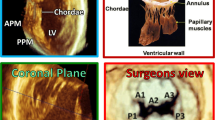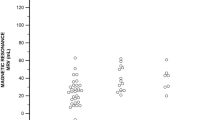Abstract
The concept of disproportionate mitral regurgitation (dispropMR) has been introduced to identify patients with functional mitral regurgitation (MR) who benefit from percutaneous treatment. We aimed to examine echocardiographic characteristics behind this entity. We retrospectively included 172 consecutive patients with reduced left ventricular ejection fraction (LVEF), and more than mild MR referred to clinically indicated echocardiography. According to the proportionality ratio (effective regurgitant orifice area (EROA)/left ventricular end-diastolic volume (LVEDV)) patients were divided into dispropMR and proportionate MR (propMR) group. Potential factors which might affect proportionality definition were analyzed. 55 patients (32%) had dispropMR. Discrepant grading of MR severity was observed when using regurgitant volume (RegVol) by proximal isovelocity surface area (PISA) method or volumetric method, with significant discordance only in dispropMR (p < 0.001). Patients with dispropMR had more frequently left ventricular foreshortened images for LVEDV calculation than patients with propMR (p = 0.003), resulting in smaller LVEDV in dispropMR group. DispropMR group had more substantial dynamic variation of regurgitant flow compared to propMR. Accordingly, EROA was consistently overestimated by standard single-point PISA method compared to serial PISA method. This was more pronounced in dispropMR (bias:10.5 ± 28.3 mm2) compared to propMR group (bias:6.4 ± 12.8 mm2). DispropMR may be found in roughly one third of clinically indicated echocardiographic studies in patients with reduced LVEF and more than mild MR. EROA overestimation due to dynamic variation of regurgitant flow and LVEDV underestimation due to LV foreshortening were more frequently found in dispropMR. Our results indicate that methodological limitations of echocardiographic MR grading could not be neglected in classifying the proportionality of MR.






Similar content being viewed by others
Data availability
The data underlying this article will be shared on reasonable request to the corresponding author.
References
Vahanian A, Beyersdorf F, Praz F et al (2022) 2021 ESC/EACTS guidelines for the management of valvular Heart Disease. Eur Heart J 43:561–632. https://doi.org/10.1093/eurheartj/ehab395
Feldman T, Kar S, Elmariah S et al (2015) Randomized comparison of Percutaneous repair and Surgery for mitral regurgitation. J Am Coll Cardiol 66:2844–2854. https://doi.org/10.1016/j.jacc.2015.10.018
Obadia J-F, Messika-Zeitoun D, Leurent G et al (2018) Percutaneous Repair or Medical Treatment for secondary mitral regurgitation. N Engl J Med 379:2297–2306. https://doi.org/10.1056/NEJMoa1805374
Stone GW, Lindenfeld J, Abraham WT et al (2018) Transcatheter mitral-valve repair in patients with Heart Failure. N Engl J Med 379:2307–2318. https://doi.org/10.1056/NEJMoa1806640
Senni M, Adamo M, Metra M et al (2019) Treatment of functional mitral regurgitation in chronic Heart Failure: can we get a ‘proof of concept’ from the MITRA-FR and COAPT trials? Eur J Heart Fail 21:852–861. https://doi.org/10.1002/ejhf.1491
Pibarot P, Delgado V, Bax JJ (2019) MITRA-FR vs. COAPT: lessons from two trials with diametrically opposed results. Eur Hear Journal Cardiovasc Imaging 20:620–624. https://doi.org/10.1093/ehjci/jez073
Hagendorff A, Knebel F, Helfen A et al (2021) Disproportionate mitral regurgitation: another myth? A critical appraisal of echocardiographic assessment of functional mitral regurgitation. Int J Cardiovasc Imaging 37:183–196. https://doi.org/10.1007/s10554-020-01975-6
Grayburn PA, Sannino A, Packer M (2019) Proportionate and disproportionate functional mitral regurgitation: a new conceptual Framework that reconciles the results of the MITRA-FR and COAPT trials. JACC Cardiovasc Imaging 12:353–362. https://doi.org/10.1016/j.jcmg.2018.11.006
Packer M, Grayburn PA (2020) New evidence supporting a novel conceptual Framework for distinguishing proportionate and disproportionate functional mitral regurgitation. JAMA Cardiol 5:469–475. https://doi.org/10.1001/jamacardio.2019.5971
Ooms JF, Bouwmeester S, Debonnaire P et al (2022) Transcatheter edge-to-Edge Repair in Proportionate Versus Disproportionate Functional Mitral Regurgitation. J Am Soc Echocardiogr 35:105–115e8. https://doi.org/10.1016/j.echo.2021.08.002
Lindenfeld J, Abraham WT, Grayburn PA et al (2021) Association of Effective Regurgitation Orifice Area to Left Ventricular End-Diastolic volume ratio with transcatheter mitral valve repair outcomes: a secondary analysis of the COAPT Trial. JAMA Cardiol 6:427–436. https://doi.org/10.1001/jamacardio.2020.7200
Messika-Zeitoun D, Iung B, Armoiry X et al (2021) Impact of mitral regurgitation severity and left ventricular remodeling on Outcome after MitraClip Implantation: results from the Mitra-FR Trial. JACC Cardiovasc Imaging 14:742–752. https://doi.org/10.1016/j.jcmg.2020.07.021
Adamo M, Cani DS, Gavazzoni M et al (2020) Impact of disproportionate secondary mitral regurgitation in patients undergoing edge-to-edge percutaneous mitral valve repair. EuroIntervention 16:413–420. https://doi.org/10.4244/EIJ-D-19-01114
Zoghbi WA, Adams D, Bonow RO et al (2017) Recommendations for noninvasive evaluation of native valvular regurgitation: a report from the American Society of Echocardiography Developed in Collaboration with the Society for Cardiovascular Magnetic Resonance. J Am Soc Echocardiogr 30:303–371. https://doi.org/10.1016/j.echo.2017.01.007
Lang RM, Badano LP, Mor-Avi V et al (2015) Recommendations for Cardiac Chamber quantification by Echocardiography in adults: an update from the American Society of Echocardiography and the European Association of Cardiovascular Imaging. J Am Soc Echocardiogr 28:1–39e14. https://doi.org/10.1016/j.echo.2014.10.003
Lancellotti P, Pibarot P, Chambers J et al (2022) Multi-modality imaging assessment of native valvular regurgitation: an EACVI and ESC council of valvular Heart Disease position paper. Eur Hear J - Cardiovasc Imaging 23:e171–e232. https://doi.org/10.1093/ehjci/jeab253
Buck T, Plicht B, Kahlert P et al (2008) Effect of dynamic Flow Rate and Orifice Area on Mitral Regurgitant Stroke volume quantification using the Proximal Isovelocity Surface Area Method. J Am Coll Cardiol 52:767–778. https://doi.org/10.1016/j.jacc.2008.05.028
Qin T, Caballero A, Hahn RT et al (2021) Computational analysis of virtual echocardiographic Assessment of Functional Mitral Regurgitation for Validation of Proximal Isovelocity Surface Area methods. J Am Soc Echocardiogr 34:1211–1223. https://doi.org/10.1016/j.echo.2021.06.011
Pavlou M, Ambler G, Seaman SR et al (2015) How to develop a more accurate risk prediction model when there are few events. BMJ 351:h3868. https://doi.org/10.1136/bmj.h3868
Bartko PE, Heitzinger G, Arfsten H et al (2019) Disproportionate functional mitral regurgitation: advancing a conceptual Framework to Clinical Practice. JACC Cardiovasc Imaging 12:2088–2090. https://doi.org/10.1016/j.jcmg.2019.05.005
Lopes PM, Albuquerque F, Freitas P et al (2022) Assessing proportionate and disproportionate functional mitral regurgitation with individualized thresholds. Eur Hear Journal Cardiovasc Imaging 23:431–440. https://doi.org/10.1093/ehjci/jeab023
Gorlin R, Dexter L (1952) Hydraulic formula for the calculation of the cross-sectional area of the mitral valve during regurgitation. Am Heart J 43:188–205. https://doi.org/10.1016/0002-8703(52)90210-X
Grayburn PA, Sannino A, Packer M (2021) Distinguishing proportionate and disproportionate subtypes in functional mitral regurgitation and left ventricular systolic dysfunction. JACC Cardiovasc Imaging 14:726–729. https://doi.org/10.1016/j.jcmg.2020.05.043
Gaasch WH, Meyer TE (2018) Secondary mitral regurgitation (part 1): volumetric quantification and analysis. Heart 104:634–638. https://doi.org/10.1136/heartjnl-2017-312001
Asch FM, Grayburn PA, Siegel RJ et al (2019) Transcatheter mitral valve replacement in patients with Heart Failure and secondary mitral regurgitation: from COAPT Trial. J Am Coll Cardiol. https://doi.org/10.1016/j.jacc.2019.09.017
Uretsky S, Aldaia L, Marcoff L et al (2020) Concordance and discordance of echocardiographic parameters recommended for assessing the severity of mitral regurgitation. Circ Cardiovasc Imaging 13:1–10. https://doi.org/10.1161/CIRCIMAGING.119.010278
Igata S, Cotter BR, Hang CT et al (2021) Optimal quantification of functional mitral regurgitation: comparison of volumetric and proximal isovelocity surface area methods to predict outcome. J Am Heart Assoc 10:1–9. https://doi.org/10.1161/JAHA.120.018553
Altes A, Levy F, Iacuzio L et al (2022) Comparison of mitral regurgitant volume Assessment between Proximal Flow Convergence and Volumetric methods in patients with significant primary mitral regurgitation: an echocardiographic and cardiac magnetic resonance imaging study. J Am Soc Echocardiogr 35:671–681. https://doi.org/10.1016/j.echo.2022.03.005
Hagendorff A, Knebel F, Helfen A et al (2021) Echocardiographic assessment of mitral regurgitation: discussion of practical and methodologic aspects of severity quantification to improve diagnostic conclusiveness. Clin Res Cardiol 110:1704–1733. https://doi.org/10.1007/s00392-021-01841-y
Ünlü S, Duchenne J, Mirea O et al (2020) Impact of apical foreshortening on deformation measurements: a report from the EACVI-ASE strain standardization Task Force. Eur Hear Journal Cardiovasc Imaging 21:337–343. https://doi.org/10.1093/ehjci/jez189
Schwammenthal E, Chen C, Benning F et al (1994) Dynamics of mitral regurgitant flow and orifice area. Physiologic application of the proximal flow convergence method: clinical data and experimental testing. Circulation 90:307–322. https://doi.org/10.1161/01.CIR.90.1.307
Enriquez-Sarano M, Sinak LJ, Tajik AJ et al (1995) Changes in effective regurgitant orifice throughout systole in patients with mitral valve prolapse. Circulation 92:2951–2958. https://doi.org/10.1161/01.CIR.92.10.2951
Gaasch WH, Aurigemma GP, Meyer TE (2020) An Appraisal of the Association of Clinical Outcomes with the severity of regurgitant volume relative to end-diastolic volume in patients with secondary mitral regurgitation. JAMA Cardiol 5:476–481. https://doi.org/10.1001/jamacardio.2019.5980
Funding
This work was supported by the University Medical Centre Ljubljana, Slovenia [grant number 20200232].
Author information
Authors and Affiliations
Contributions
Conception and design of manuscript study, or both (J.A., and M.C.); Analysis and interpretation of data, or both (J.A., M.R., B.B., N.S., J.T., M.B., M.C.); Manuscript drafting or critical revision for important intellectual content (J.A., M.R., B.B., N.S., J.T., M.B., M.C.); Final approval of the manuscript submitted (J.A., M.R., B.B., N.S., J.T., M.B., M.C.).
Corresponding author
Ethics declarations
Ethical approval
This research study was conducted retrospectively from data obtained for clinical purposes. The study protocol was approved by the National Medical Ethics Committee.
Consent to participate
This is an observational retrospective study. The Slovenian Research Ethics Committee has confirmed that no informed consent is required.
Competing interests
The authors declare no competing interests.
Additional information
Publisher’s Note
Springer Nature remains neutral with regard to jurisdictional claims in published maps and institutional affiliations.
Electronic supplementary material
Below is the link to the electronic supplementary material.
Rights and permissions
Springer Nature or its licensor (e.g. a society or other partner) holds exclusive rights to this article under a publishing agreement with the author(s) or other rightsholder(s); author self-archiving of the accepted manuscript version of this article is solely governed by the terms of such publishing agreement and applicable law.
About this article
Cite this article
Ambrožič, J., Rauber, M., Berlot, B. et al. Challenges and pitfalls in classification of disproportionate mitral regurgitation. Int J Cardiovasc Imaging 40, 757–767 (2024). https://doi.org/10.1007/s10554-023-03043-1
Received:
Accepted:
Published:
Issue Date:
DOI: https://doi.org/10.1007/s10554-023-03043-1




